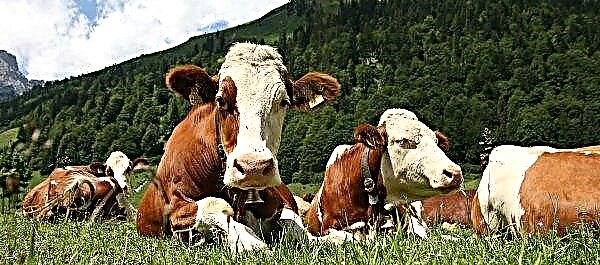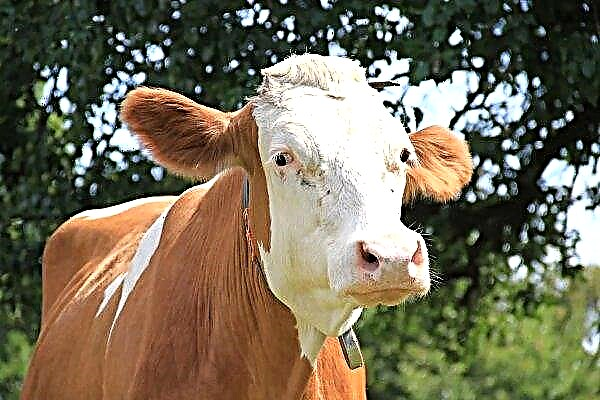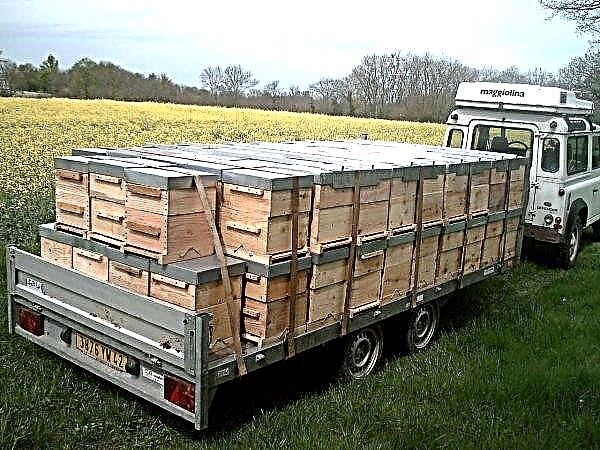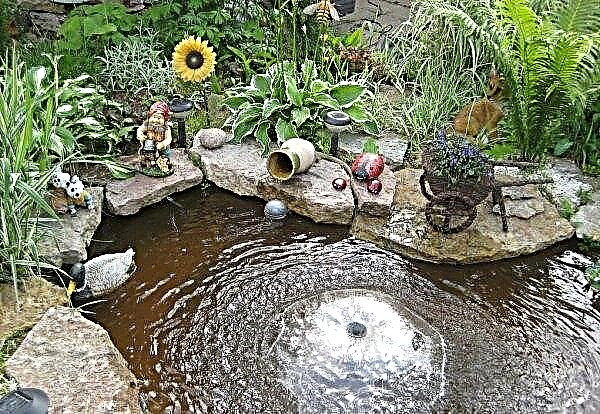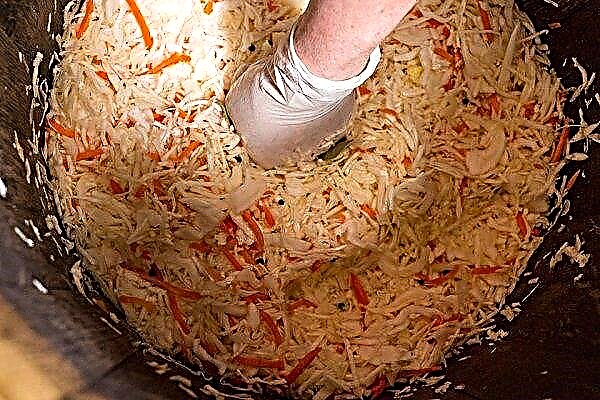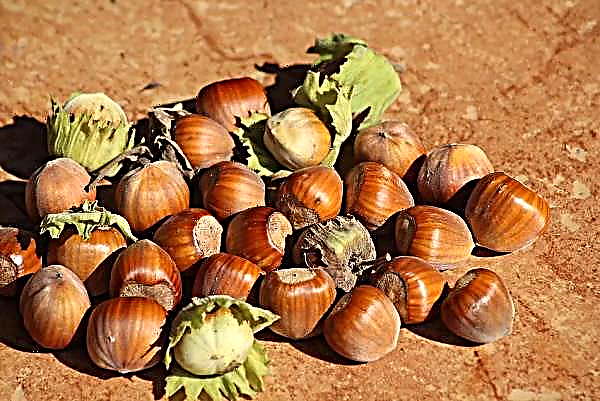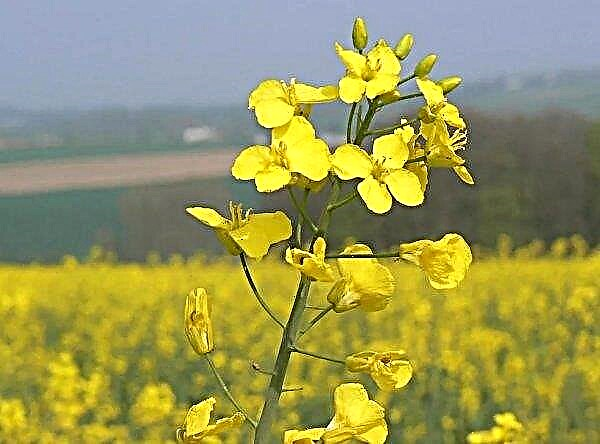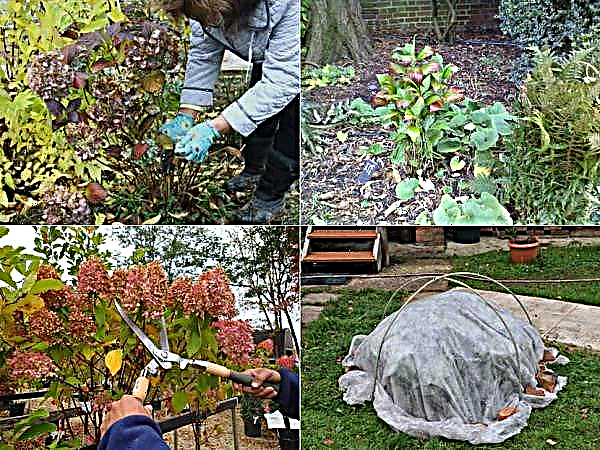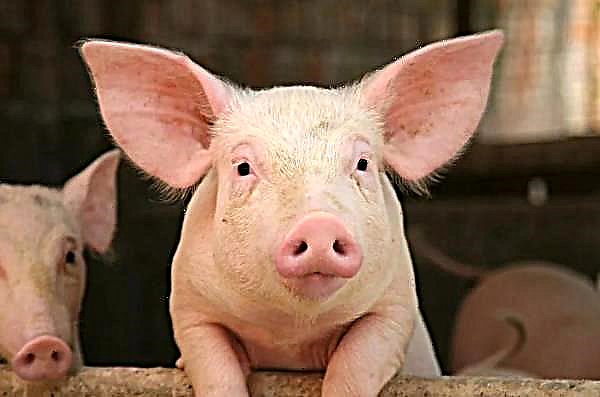Juniper Siberian is a perennial plant with ornamental needles, which can be grown even in the northern regions with a harsh climate. This culture is unpretentious in care and breeds well at home, so many gardeners cultivate it on the site and at home. The botanical description of the plant and its useful properties, the rules of planting and propagation of juniper, as well as the features of caring for the shrub - further in the article.
Botanical Description
The Latin name for Siberian juniper is Juniperus sibirica Burgsd. This evergreen coniferous plant belongs to the Cypress family and received its first description in 1787. The characteristic of this species was given by the German forester Friedrich August Ludwig von Burgsdorf.
Did you know? The oldest bush of juniper grows on the peninsula of Crimea. His age is more than 2000 years.
Botanical crop description:
- The height of the bush does not exceed 1 m, and the annual growth is about 0.5 cm.
- The root system is powerful, goes into the soil to a depth of 2 m.
- The trunk and branches of the plant are covered with a smooth bark of gray-brown or light brown color.
- Crohn creeping, thick. It is formed by short and thick trihedral shoots, as well as young shoots. Branches lying on the ground can take root over time, capturing a large area around the main trunk of the plant.
- The shoots along the entire length are densely covered with stiff needle-shaped needles, growing in bunches of 3 pieces. It is slightly pressed against the branches and can reach a length of 8–10 mm.
- The needles of the plant are saber-shaped and end with a subulate tip. On their upper surface there is a groove with a bluish-white stomatal stripe, and the lower part of the needles is colored green.
- Male inflorescences are sessile, and their length is 2-3 times less than the length of the needles.
- The diameter of the spherical cone berries is 6–8 mm, and their surface is painted dark blue with a slight bluish coating.
- Seeds ripen within 2 years. They are inside fleshy cones (2-3 in each fruit), have an oval shape and brown color.
- The fruiting period lasts from June to August. It takes 2 years from the moment of pollination to ripen the fruit.
- The life span of a plant is several centuries and can reach 600 years.

Benefits and healing properties
Juniper bushes release a large number of volatile products into the surrounding air, purifying it from bacteria and harmful impurities, therefore it is useful to plant them near roads. In folk medicine, the cones of this plant are used to prepare a variety of tinctures and decoctions.
Important! Remedies from juniper contribute to the regeneration of damaged lung tissue, therefore they are often used to treat tuberculosis.
- The main medicinal properties of fruits:
- have a diuretic effect;
- are a source of valuable essential oil used to treat infectious diseases;
- lower blood pressure with hypertension;
- help cure gallstone disease;
- beneficial effect on the liver;
- purify the blood;
- help eliminate edema;
- relieve pain in diseases of the joints;
- eliminate digestive problems (nausea, flatulence);
- contribute to the separation of sputum during a cold, accompanied by a cough.
Where it grows in nature
In the natural environment, Siberian juniper can be found in the mountains, on rocky embankments and slopes, as well as in deciduous woodlands and zones with a moderate type of climate. Bushes usually grow in groups, forming small thickets.

The main regions of distribution of the plant:
- slopes of the Himalayas;
- Central and East Asia;
- Far East;
- Eastern North America
- Eastern Europe;
- Kurile Islands;
- Greenland;
- Siberia and the Caucasus;
- Tibet;
- Crimean peninsula.
Landing
Juniper Siberian is a very hardy plant, therefore, it can grow even on poor soils in cold climates. But when planting a plant on a site, it is necessary to take into account that the bush grows in width over time, so juniper needs a sufficient amount of free space.
In order for the young bush to take root safely in the open ground, you need to prepare the site, select high-quality planting material and correctly perform its incorporation into the soil.
Video: Planting and caring for juniper
Site preparation
It is recommended to plant Siberian juniper in open ground in early spring after snow melts so that the young bush does not suffer from frost. In areas with mild winters, it is allowed to plant the plant in the soil in autumn.
The section for planting juniper must meet the following requirements:
- well lit by the sun (only a small partial shade is acceptable);
- have light, loose and not too fertile soil (sandy or peaty);
- do not contain groundwater, lying too close to the surface of the earth.
Important! Depressions for planting Siberian juniper are prepared in about 2 weeks. In this case, a distance of 1.5–2.5 m is left between neighboring plants.
The planting pit should have a depth and diameter of about 1 m. A drainage layer of broken brick, pebbles and coarse sand with a thickness of 15–20 cm must be laid on its bottom. To fill the pit, a loose soil mixture of sod land, peat and sand is prepared by mixing these components in 1: 2: 1 ratio.

Seedling preparation
For the successful cultivation of Siberian juniper in your area, you need to use high-quality planting material. It is recommended to buy it in specialized stores and nurseries, paying attention to the appearance of a young bush.
Did you know? In ancient Rome, juniper branches fumigated rooms in which there were cases of cholera, thus preventing the further spread of infection.
Signs of a strong and healthy seedling are:
- closed root system with a moderately moist earthen lump around it;
- smooth trunk, without growths and traces of damage by diseases or pests;
- stiff and elastic needles without yellowness and dry patches.

Before planting an earthen lump around a juniper seedling, you need to moisten well. For additional protection against diseases and pests, you can spill the soil around the roots of the bush with a weak solution of potassium permanganate.
Step-by-step instructions for planting Siberian juniper:
- Fill the landing pit with previously prepared loose soil mixture to 1⁄2 depth. Pour 10 liters of water into the recess.
- Lower the seedling into the pit along with an earthen lump. The root neck should be at the same level with the surface of the earth.
- Fill the recess with the remaining soil mixture to the very top. Seal the ground around the bush with your hands.
- Pour the seedling with warm water so that the earth around it is wet to a depth of 0.5 m.
- When the moisture is completely absorbed, mulch the area of the trunk circle with pine bark, dry wood sawdust or peat.

Caring for Siberian Juniper
After the juniper has successfully taken root in the area, it is very easy to take care of the bush. The plant is unpretentious, so even a novice gardener can cultivate it. In the process of growing it is necessary to provide the juniper with the correct watering, periodically feed it with fertilizers and prune annually. To prevent problems, preventive measures are taken to protect the bush from possible diseases and pests.
Watering and feeding
Juniper Siberian tolerates drought well and practically does not need fertilizers. But young plants for normal development need to provide sufficient moisture and nutrients.

The basic rules of watering and fertilizing the crop:
- young plants after planting are watered regularly as the topsoil dries up;
- after reaching the age of 3-4 years, the bush is irrigated only during the dry summer, carrying out 2-3 irrigation per season;
- in dry and hot weather they perform sprinkling of the crown - the procedure is carried out at sunset every 7 days;
- the first 2–3 years of cultivation, juniper is fed 2 times per season - in the spring, complex fertilizers containing nitrogen are applied, and in the autumn they are fed with phosphorus-potassium preparations;
- an adult plant is fed only in spring, introducing 30–40 g nitroammophoski per 1 m² of area.
Important! If Siberian juniper was attacked by diseases and pests, then for quick recovery it is fed with fertilizers 2 times a season, regardless of age.
Mulching
A layer of mulch helps to retain moisture in the soil longer, and also keeps the soil loose. For this purpose, use rotted wood sawdust, peat or dry pine bark. To mulch the area around the juniper, you need to carefully raise its creeping shoots on the ground. The mulch is spread in a layer about 6-8 cm thick.
The first couple of years after planting, it is recommended to carefully loosen the earth around the plant after each rain or watering. This procedure helps to eliminate the dense earth crust formed on the ground and improve air access to the roots of the bush.

Pruning
Thanks to its shoots creeping along the ground, the Siberian juniper has a rather decorative appearance and does not need forming pruning. But the dried branches of the bush can rot from contact with the surface of the soil, so they need to be removed.
The main features of crop trimming:
- shoots can be removed in early spring or late autumn, when the bush is at rest;
- without fail, dry and damaged branches are cut so that they do not become a source of fungal diseases;
- if you need to give the bush a certain shape, then you can cut the shoots at your discretion - while they are shortened by no more than 7 cm;
- pruning is done with sharpened garden tools so as not to injure the wood too much.

Wintering
Juniper Siberian is highly resistant to low temperatures and is able to withstand frosts down to -29 ° С, therefore, does not need additional shelter for the winter. An adult bush to prepare for wintering will be plentiful abundant water-loading irrigation in the fall. In specimens with a spreading crown, the branches are tied with twine to prevent them from breaking under the weight of the snow cover.
Did you know? Geologists often look for deposits of coal in the thickets of juniper. In nature, this plant often grows above coal seams.
Young seedlings under two years of age can suffer from low temperatures, so the soil around them must be mulched, and shoots are covered with lutrasil or spruce branches.

Pest and Disease Control
Subject to the recommendations for planting and care, Siberian juniper exhibits strong immunity to diseases and pests. But in some cases, the bush may suffer from fungal infections and harmful insects.
During cultivation, the following problems may occur:
- Rust. The cause of the disease may be an increased amount of salts in the soil. The main symptom of the disease is the coloring of the needles in a dirty orange color and their further drying, as well as red growths on the surface of the shoots and the trunk. For the treatment of diseased specimens, they are treated with a solution of the Artserid preparation, which is prepared according to the instructions on the package. The procedure is carried out up to 4 times with an interval of 10 days.

- Schütte. The problem often arises as a result of increased humidity and lack of sunlight. The infection has a fungal nature and is manifested by yellowing of the needles. With the further development of the disease, the needles turn brown, and round black growths form on their surface. The infected areas are cut off and destroyed, and the bush is treated with fungicides (for example, “Fundazol”).
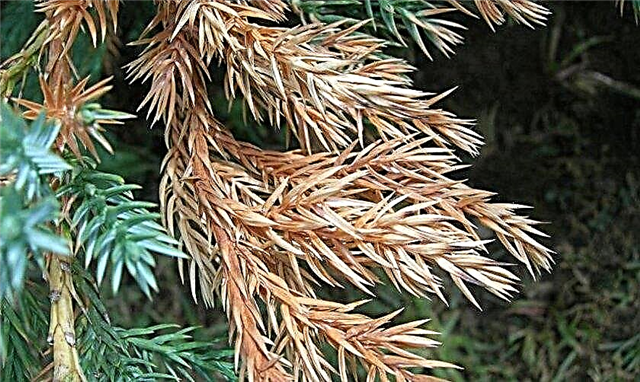
- Alternariosis. The causative agent of this disease is a fungus that multiplies on the plant with excessive thickening of the crown or as a result of contact of the shoots with the soil surface. The main symptoms of the disease are yellowing of needles and the appearance of black fluffy plaque on it. The affected areas must be cut and destroyed, and the bush treated with a solution of "Homa".

- Aphid. Insects feed on the juice of the shoots and cause the needles to dry out. Especially often pests affect young specimens, and one of the reasons for their appearance may be ants. The diseased bush is treated with Fitoverm or Aktellik, withstanding an interval of 10-14 days between treatments.

- Spider mite. This pest often appears during hot and dry weather. At the same time, on the shoots of the juniper you can see a thin cobweb enveloping the needles, and the affected bush gradually turns yellow and dries. Against the pest, use the drug "Karate" or "Fufanon", clearly following the instructions on the packaging.

- Shield. The insect is small, but you can notice its appearance on the bush by the voluminous brown growths on the surface of the needles and bark of the shoots. As a result of infection, deformation and death of the branches is observed. For the treatment of plants, “Karbofos” is used, and the dosage and frequency of treatments are determined according to the instructions on the packaging of the product.

To prevent the appearance of diseases and pests, you can use these preventive measures:
- juniper planting in a well-lit place;
- the use of high-quality and healthy planting material;
- adherence to watering and dressing schedules;
- spraying the crown of the bush with a 1% solution of Bordeaux fluid in spring and autumn;
- annual sanitary pruning;
- processing of all sections with garden varn for disinfection.
Did you know? Juniper berries are used in cooking to prepare marinades and savory meat sauces. They are also added to compotes and juices as a natural flavor.
Breeding
Siberian juniper is propagated using seeds and cuttings. Shoots creeping along the surface of the soil can also take root, but it is rather difficult to determine the place on the branch where the roots formed, and the children received do not tolerate the transplant well.
When propagated by seeds, planting material can be collected independently or bought in a specialized store. The cuttings of branches obtained during the spring trimming of the juniper crown are usually used as cuttings.

Seeds
Growing juniper seeds is a very time-consuming and lengthy process.requiring from the gardener certain efforts and time. You can collect seeds from plants from the age of 2 years, tearing cones from them during the darkening period.
Important! You can not use planting material collected from completely blackened fruits. Such seeds enter into a kind of hibernation, so they will germinate for a very long time.
The landing instruction includes the following actions:
- Prepare the container, fill it with a mixture of peat, sand and moss. Well moisten the resulting loose substrate.
- Soak the planting material in a 3% potassium permanganate solution for half an hour. To stimulate germination, you can additionally withstand seeds in a solution of liquid fertilizer (for example, "Kornevina") for 2 hours.
- Plant the seeds in a container, observing an interval of 2-3 cm between them. Sprinkle planting material on top with a small layer of soil.
- For natural stratification, take the container outside, leaving it under the snow for the entire cold season.
- In May, extract stratified seeds from the container. Plant them in open ground on a temporary bed according to the scheme 50 × 80 cm.
 The first seedlings usually appear 1-3 years after planting material is embedded in the soil. After this, the plants are grown for another 2 years on a temporary bed, and then the seedlings are transplanted to a permanent place
The first seedlings usually appear 1-3 years after planting material is embedded in the soil. After this, the plants are grown for another 2 years on a temporary bed, and then the seedlings are transplanted to a permanent place
Cuttings
This method of propagation is used much more often, because planting material can be obtained during spring pruning of the bush, and the rooting of cuttings reaches 80%.
Step by step instructions:
- Cut a 10–12 cm long annual shoot from the bush. A small piece of bark 2-3 cm long should remain on its lower part.
- Remove needles on the cut shoot, and then lower its lower part into the solution of the root growth stimulator for 24 hours.
- Prepare small individual containers. Fill them with a mixture of peat and sand, taken in equal quantities.
- Lower the base of the handle into a container, deepening it into the ground by about 3 cm. Water the soil with water and then cover the pot with a film.
- Put the container with the cuttings in a warm (about + 22 ° C) and a bright place. Periodically ventilate seedlings by lifting the film briefly. Carry moderate watering as the topsoil in the pot dries.
Did you know? In ancient Russia, juniper bark was used for making dishes. In such containers, milk did not sour for a long time, even in extreme heat.
Usually 30–45 days are enough to root the cuttings. After that, the film is removed, and the plants are grown in a pot for 2-3 years. After this time, the young seedling is ready for transplanting to a permanent place.

Features of growing a house
Juniper Siberian has a small height, so it can be grown not only in an open area, but also as a houseplant. In this case, planting is performed in an individual tank, on the bottom of which a drainage layer is necessarily laid.
Important! The plant does not respond well to transplantation, so this procedure is carried out only in case of emergency. The optimal time is March or November.
Features of growing a bush at home:
- a pot with a plant is placed in a well-lit place;
- moderate watering is carried out as the soil dries in the tank (in winter it is enough to irrigate the bush 1-2 times a month);
- in the warm season, the crown of the juniper is sprayed from the spray gun with warm water every 4-7 days;
- in summer, a pot with a plant is recommended to be taken outside;
- fertilizers are applied according to the same schedule as for the street bush;
- for the winter, juniper is cleaned in an unheated and well-lit room - here it is kept until spring at a temperature of no more than + 10 ° C;
- in spring and late autumn, sanitary and forming crown trimmings are performed.

Use in landscape design
Bushes of Siberian juniper often act as a decorative decoration of the site. Particularly attractive are the evergreen branches of the plant in winter, on white snow.
In landscape design, culture is used in several ways:
- in group plantings with heather, roses;
- for the design of rocky embankments and alpine slides;
- in solitary landings on the slopes.
Juniper Siberian is completely unpretentious to climate conditions, and caring for it does not require much time and effort. The plant can be grown indoors and outdoors, and also use it as a decorative element in landscape design.







